Place of Publication
Pl. Altoandinas Fl. Silv. Chile: 140 (1998b)
Type citation
Chile. Metropolitana: Alfalfar, Dec 1887, L. Kunze s.n. (lectotype here designated: SGO! [SGO000004516 acc. #055328]; isolectotype: SGO! [SGO000004515 acc. #042891]).
Synonyms
Common names
- mariposita roja (Hoffmann et al. (1998b))
References
-
Hoffmann et al. (1998b)
Hoffman, A. , Liberona, F. , Muñoz, M. and Watson, J. 1998b. Plantas altoandinas en la flora silvestre de Chile. Santiago de Chile: Fundación Claudio Gay
-
Muñoz-Schick & Moreira-Muñoz (2008b)
Muñoz-Schick, M. and Moreira-Muñoz , A 2008. El género Schizanthus (Solanaceae) en Chile. Revista Chagual (Jardín Botánico Chagual, Santiago) 6: 21–32.
-
Morales-Fierro et al. (2020)
Morales-Fierro, Vanezza , Muñoz-Schick, Mélica and Moreira-Muñoz, Andrés 2020. Synopsis of Schizanthus Ruiz & Pav. (Solanaceae), a genus endemic to the southern Andes. PhytoKeys 154: 57–102
Iconography
- Morales-Fierro et al. (2020): fig. 4i–l





